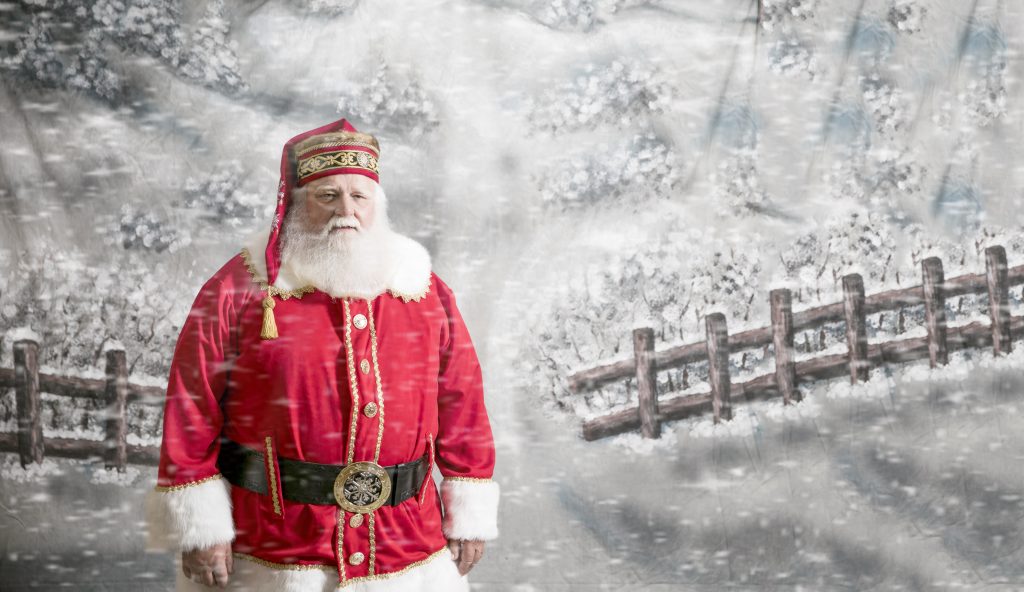Fielding difficult requests (such as a wish for divorced parents to reunite) dealing with crying toddlers, and attending to grooming matters, such as beard bleaching, are realities for the jolly gents who play Santa
A retired sergeant from the Hartford police force, Charles Allen, was not looking for a new job. But ten years ago while visiting Fantasia of Lights inHartford’s Goodwin Park with his family, Allen, then age 77, got a job offer from an unlikely source: Santa Claus.“There was a Santa at the entrance greeting everyone,” recalls the white-bearded Allen, of Rocky Hill. “He saw me and came over to our car and mentioned quietly that he had more [Santa] business than he could handle if I was interested.”Intrigued, Allen, who had never considered being Santa as a business, did some online research and found himself enrolling in a web-based Santa training program. Allen is one of an estimated 70,000 people across America who will don the red suit this holiday season at shopping malls, parades, and holiday parties. Being the man in red can generate some significant green, according to New Hampshire’s Dan Greenleaf, 65, a co-founder of the New England Santa Society, a volunteer-based organization designed to help train aspiring Kringles across the northeast. “In Connecticut, a Santa with some training can earn well over $150 an hour,” says Greenleaf, who typically makes more than 50 appearances during the holiday season. “In the Boston area, it’s closer to $250 an hour.” George McCleary, 62, of Thomaston, has played the role of Santa more than 600 times since 1972. He estimates he can earn more than $10,000 annually, between Thanksgiving and Christmas, from 50 clients, including Eversource Electric, Microsoft, New England Sports Center and Bass Pro Shops. Last year, he booked more than 70 events. Like many would-be Santas, McCleary sees the financial upside of becoming Saint Nick as secondary to the joy he experiences.
“There is a magical connection between Santa and a child,” McCleary says. Sometimes that magic is tested. “The hardest, most challenging situation I ever had [as Santa] was going with Mrs. Claus to Newtown, three days after the [Sandy Hook] school shootings,” McCleary says. The children, he recalls, were understandably subdued, but he followed his normal routine. The first child he saw, McCleary says, wanted nothing. “The next boy, when I asked what we wanted, said a football,” McCleary recounts. “I reached into my bag, grabbed a present, and as luck would have it, it was a football.” The child smiled.The difficult requests that can reach Santa’s ear – a wish for divorced parents to get back together, or for the return of a deceased relative, or for a parent on a tour of duty to come home – require finesse. “You never want to promise something to a child you can’t deliver,” McCleary says. “I’ve been fortunate to attend trainings that feature table discussions and practical tips on how to address sensitive topics and accommodate children with special needs.”Groups like the New England Santa Society and the Connecticut Society of Santas conduct educational workshops throughout the year, most heavily in autumn. “We have trainings for both novices and more seasoned Santas,” Greenleaf says. For newcomers, training covers the basics – learning the history of Santa Claus, grooming tips, dealing with difficult children, and finding Santa jobs. Santas with more experience under their wide black belts might learn magic tricks or balloon crafts to add a new twist to their events.
For many toddlers, visiting Saint Nick can be a scary experience and a trying one for an unprepared Santa. Greenleaf says he trains his students, when dealing with a frightened child, to connect with parents first. “Once you get the seal of approval from mom or dad, the child usually opens up,” Greenleaf says. “Sometimes it takes a prop like a book, toy or puppet; there are a lot of approaches we teach.”Ed Dorsett, 74, of Morris, was one of nearly 20 Santas trained in the state last year by the Connecticut Society of Santas. He was inspired to try his hand at being Santa when strangers commented on his physical similarities to Mr. Kringle. In his first year, he booked more than 25 appearances, including one at Foxwoods Resort Casino. Dorsett learned it’s not always Santa who teaches the meaning of Christmas. “One girl presented me with two lists: a personal one and one for the underprivileged and homeless; she chose to talk about the second one,” he says. “I told her how pleased that made me.”Greenleaf says a big part of connecting with children is building trust. “You need to have a love of children and accept them where they are [in that moment] in a way that is believable,” he says. It’s also important, he cautions, to authentically look the part. A good quality suit, boots, belt and buckle, and, in some cases, beard-bleaching, are essentials. “It can cost a couple thousand dollars just to get the basics,” Greenleaf says. “And that doesn’t include things like business cards, background checks and insurance.” (Yes, even Saint Nick needs liability coverage.)While annual costs can run well into the upper hundreds of dollars between training classes and grooming, the market demand for Santa during the holiday season outpaces the supply. That’s made it easier, even for novice Santas, to cash in. “I get booking requests earlier each year,” says Greenleaf, who uses online Santa sites and social media to generate business leads. “Many clients started to called this past March and April for events this December.”During the holidays, one of the biggest challenges for local Santas is fitting in all their appearances.
Typically, the weekends – which can provide $2,000 in income, according to Greenleaf – book quickly. “I try to reserve mid-week events for places like schools or nursing homes,” he says, noting he’s appeared in parades, at children’s hospitals, stores and tree lighting ceremonies during his nine years in Santa’s shoes. And it’s not just children, Greenleaf’s found, that rejoice when he’s in character. “When I interact with the parents or the elderly I can see [on their faces] the childhood memories [of Santa] coming back,” he says. “It’s not just a role you play; there’s a much more important connection for people.”Charles Allen, now 87 and a decade into his post-retirement career as Santa, agrees. “I decided when I started [as Santa] that I wanted to do more than ‘meet and greets’, he says. “Because being Santa provided a greater power of influence with children.”He developed a program called Life Experiences and uses his time as Santa to teach children tolerance, respect and the importance of a positive attitude. “The first rule I teach is the golden rule – treat others as you want to be treated,” he explains. “When I tell kids how proud of them when they know that rule, their ego goes through the ceiling.”The power and satisfaction Allen feels being Santa surpasses anything he experienced in his previous careers. In addition to being a police officer, he’s been a teen counselor, florist, wedding videographer and wedding consultant.

“Being Santa is the best thing that ever happened to me,” he says. “The happiest people are those that make others happy.” This season, many Santas across Connecticut will earn a sleigh’s worth of money at malls, parades and holiday parties across the state, but for many, like Charles Allen, that will never be their primary motivation. “As Santa, when you look into the eyes of a child, you see their true love,” he says, “because you [as Santa] are their hero.”
SUITING UP
If you’re inspired to launch a career as Santa, consider these qualifications, courtesy of Dan Greenleaf, co-founder of the New England Santa Society, a volunteer-based organization that helps train aspiring Kringles.
OPENNESS: Many think Santa needs a big round jelly belly to don the red suit. But Santa comes in all shapes and sizes. What he can never have too much of is heart – a boundless spirit of love, giving and joy. His spirit should spark joy in everyone regardless of their age.
IMAGINATION: For optimum connection, Santa needs to see the world from a child’s perspective. Whimsy, mischievousness, innocence, optimism, playfulness, acceptance and wonder are important qualities.
POSITIVE ENERGY: Santa must always be a jolly old elf even when fatigue, boredom or frustration kicks in.
VERSATILITY: The best Santas are multitalented. Santa could be called on to read a story to toddlers, lead a rendition of “Jingle Bells,” help assemble a new toy, visit a child in the hospital, help decorate Christmas cookies, or greet thousands along a parade route.
INCLUSIVENESS: Santa needs to be able to read and respond appropriately to people of all ages and types, from hesitant youngsters and rowdy teenagers to office workers and senior citizens. When things don’t go as planned or conflict occurs, Santa is the one who needs to maintain order and stability.
AUTHENTICITY: One must think as Santa, answer questions as Santa, interact as Santa and present oneself as the real Santa. Allowing children (and adults) to interact with the real Santa Claus is the number one priority.
Matthew Broderick is a freelance writer who lives in Simsbury with his three children.
Photographer Amber Jones, of Avon, is a frequent contributor to Seasons and owns Studio Pura in West Hartford. For more about Amber, visit amberjones.com.






More Stories
Skin Deep
Sweet Indulgences
Creative Entrepreneurs